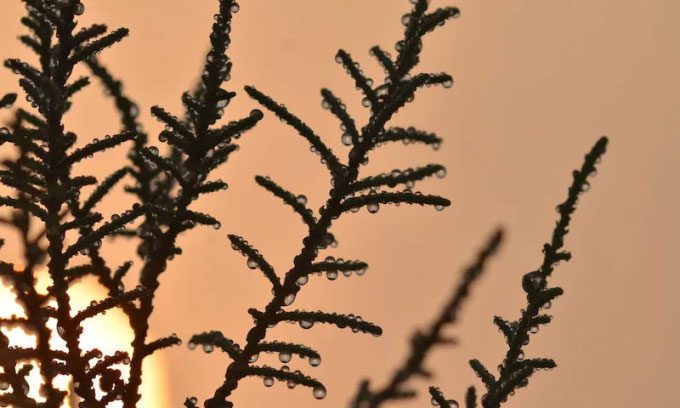The method by which salt crystals on the leaves of the desert plant Tamarix aphylla absorb water could help improve water collection technology in arid environments.
In the dry and scorching desert, plants have developed various ways to extract and store fresh water from their surroundings, such as extending their roots deep into the ground to tap into groundwater. Now, researchers have discovered a unique new mechanism: absorbing water from the air through salt crystals on their leaves, as reported by Smithsonian on November 13. This new study was published in the journal Proceedings of the National Academy of Sciences.

The Tamarix aphylla plant can survive in saline environments by excreting saltwater through its leaves. (Photo: Marieh Al-Handawi/NYU Abu Dhabi).
The Tamarix aphylla plant, belonging to the Tamaricaceae family, is a type of salt-secreting plant adapted to thrive in high salinity soils. They are native to the deserts of Africa and the Middle East.
This plant absorbs saltwater through its roots, takes what it needs, and then excretes the excess concentrated saltwater through glands on its leaves. “The water droplets do not fall but adhere to the surface,” explained Pance Naumov, a co-author of the study and a chemist at New York University Abu Dhabi. The water evaporates under the desert heat, leaving white salt crystals on the plant’s leaves. At night, these crystals begin to swell with water.
To accurately measure the amount of water absorbed by the salt crystals, the research team placed a freshly cut branch of Tamarix aphylla into a chamber simulating desert conditions in the laboratory. They weighed the branch every 20 minutes and found that after two hours, it had absorbed about 15 milligrams of water. They then cleaned the branch to remove the salt crystals and repeated the experiment. This time, the plant could only absorb 1.6 milligrams of water.
“This result was decisive for us, proving that salt is the main agent for water collection, not the plant’s surface,” stated Marieh Al-Handawi, a co-author of the study and a materials scientist at New York University Abu Dhabi.
The research team also conducted other tests and found that the Tamarix aphylla plant has a water adhesion capability nearly twice that of Teflon. They analyzed the composition of the salt crystals on the leaves and discovered that they contained at least 10 minerals, including sodium chloride, gypsum, and lithium sulfate. This combination of minerals aids in moisture absorption from the air, even when humidity levels are relatively low, around 55%.
Perhaps the salt crystals provide a method for the plant to absorb water, according to Maheshi Dassanayake, a biologist at Louisiana State University, but she does not believe that the plant actually uses the amount of water absorbed by the salt crystals. “I have yet to see mechanical evidence of how this plant uses energy to obtain water,” she remarked.
However, Naumov noted that understanding how this mechanism works could inspire new technologies for water collection from the air, helping humans create more environmentally friendly methods or improve current artificial rainmaking techniques.




















































